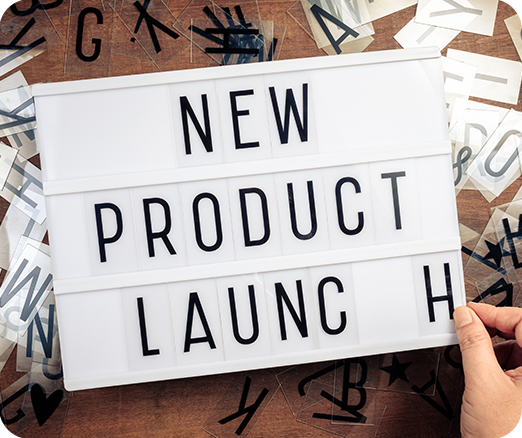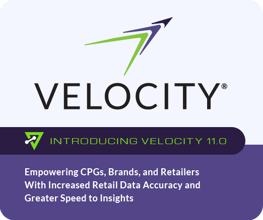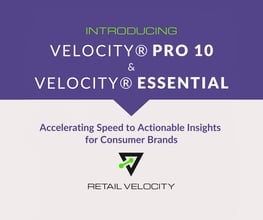
Improving New Product Launches with Retail Data Analytics
Table of Contents
- New Product Launch Challenges and Considerations
- When and How to Use Data for a New Product Launch
- What a Daily Dose of Data Can Do for Your Product Launches
- Metrics That Matter
- New Heights for Your New Product Launches
Launching a new product or a brand extension is one of the best ways for a consumer packaged goods (CPG) company to stay relevant and competitive and fuel its short- and long-term growth and profitability. It’s important for a brand to stand out, especially in the online marketplace where there are countless consumer products—and new ones and new competitors seemingly popping up every day.
New product launches, as well as pre-launch and post-launch product optimization, require a great deal of resources, research, data, and analysis—and they rarely go off without hitting a few speed bumps along the way. However, planning, executing, and evaluating your product launches and enhancing those products to make them more valuable and appealing to both current consumers and new ones can be much easier than you think.
Speed to market and launching during the prime window of opportunity, no doubt, are critical to new product introduction success. But launching and optimizing the “right way” to maximize initial sales, satisfy retailer partners, and sustain growth depends greatly on in-depth insights and collaborative, evidence-based decision-making based on the richest retail data and retail data analytics available.
If your company has a “set it and forget it” data and analytics strategy, your product launch will probably go well initially. But if you’re not regularly reviewing data to evaluate the effectiveness of your plans and performance post-launch, you won’t gain the insights needed to make the necessary strategic adjustments to ensure continued growth and profitability.
Read on to learn how reliable retail data analytics can help your new product launches reach new heights.
NEW PRODUCT LAUNCH CHALLENGES AND CONSIDERATIONS
Launching a new consumer product comes with its fair share of challenges. Here are three factors that must be considered and nailed down, whether your product is designated for the physical or digital shelf. And yes, the effectiveness of these relies on accurate retail data and analytics.
Market Research
Often, product launches fail because not enough time and thought are put into market research. It’s pivotal to pinpoint your target market, target audience, and buyer personas, as well as the appropriate channels and retailers, before launch. If you don’t, your product might not get in front of the consumers who need it and likely won’t move off the shelves. CPGs should also establish secondary and tertiary audiences for launching following the initial product release.
Launch Timing and Speed to Market
Launching a new product during the prime window of opportunity to appeal to consumers is crucial to optimizing sales, revenue, and profit. Products that launch too late are less likely to sell because your competitor may have already capitalized on the opportunity with their new product. Conversely, products that launch too early might not sell because the consumer demand for that product may not exist yet or to the degree necessary to meet sales and revenue goals. Also, shortening the time to market for a new product, when done effectively, allows you to launch in the time frame you want instead of rushing your process or missing that prime window.
Meeting Consumer Demand
If a product does take off after launch—especially much more than forecasted—there should be a coordinated plan between sales and supply chain teams for ramping up production and distribution to meet consumer demand and retail replenishment requirements. This plan should be supported by reliable and detailed data and data sharing. Long wait times and backorders can easily deter current and potentially new consumers from seeing their purchase through, and it can prevent new customers from becoming repeat, loyal customers.
WHEN AND HOW TO USE DATA FOR A NEW PRODUCT LAUNCH
Launching a new product can be, and should be, an exhilarating time for a consumer brand. But it can also be quite stressful. It involves a tremendous amount of time, resources, collaboration, and planning—not only for the initial launch but also for promoting and optimizing the product over its lifecycle. This process could take months, and in some cases, years.
Naturally, you want consumers to be excited about and interested in your company’s latest innovation, and you want your retail partners to buy in and provide you with valuable shelf space to help meet the anticipated high demand. Your marketing efforts, trade promotion activity, and strength of customer relationships will be a major factor in accomplishing all of that. But when and how you use data—and you should be using a lot of it—will determine how far you take your product launches.
Before Launch
Prior to a product launch, it’s important to collect and aggregate as much data as possible on the product’s category, retailers, competitors, and competitors’ similar products. The more and better data you can analyze, the faster you can get to market while ensuring your supply chain and inventory management capabilities are in place to adequately meet consumer demand.
Initial Stages of Launch and Post-Launch
Once your product hits the market and your marketing and promotional activities are in full swing, it’s critical to monitor your product’s progress as compared to your launch plan, especially during the first few weeks. Reviewing the data early on allows you to quickly determine what part(s) of your plan is working and what is not. In doing so, you can take immediate corrective action or capitalize on growth opportunities.
Analyzing the data daily in the initial stages versus weekly or monthly can help you identify, prevent, and resolve any issues before they become costly or unresolvable. For example, if a product isn’t moving, is it a pricing or inventory issue? Did the competition introduce their own new product or a new promotion? Having the timeliest information will allow you to get to the root cause of any issue and adjust accordingly to ensure on-shelf availability and sales.
WHAT A DAILY DOSE OF DATA CAN DO FOR YOUR PRODUCT LAUNCHES
CPGs that employ a data-driven growth strategy that leverages the most granular data, analytics, and insights significantly increase their chances of long-term success with their product launches and product optimization. This is the case whether a company is small or large; reliable data drives more-informed decision-making at all levels and with all departments.
To assess product launch success most accurately and effectively, CPGs should be looking at daily, harmonized store-level point-of-sale (POS) data and integrating it with internal and third-party data to feed their decision support technologies. Making this single source of clean data available to all teams—sales, marketing, supply chain, operations, and more—puts everyone on the same page and provides the business intelligence needed to make collaborative decisions to meet short-term and long-term new product performance and revenue goals.
Metrics that Matter
Daily store-level POS data supports several key metrics that any CPG, regardless of size, should be measuring to gauge the success of its product launch.
Product Sales and Movement
When you launch a new product, you assume it is going to sell (because you used the right retail data analytics to develop your strategic launch plan!). And you hope it will sell through all your retailers. Store-level data allows you to see how product sales were with each retailer and at each retailer store location versus analyzing numbers and making assumptions and decisions at a chain level.
This level of insight lets you drill down deeper and work with internal departments and/or retailer partners to determine if there is a problem and where and how you can rectify it. For example, if you have a retailer that hasn’t moved any product, you know something is probably wrong. It might be poor marketing, or the product never made it to the store, or maybe there was a severe snowstorm and shoppers couldn’t get to the store. With store-level data, you won’t have to guess what the problem is nor guess what the solution should be.
Supply, Distribution, and Retail Replenishment
You’re already assuming your new product will sell, but what happens if sales go through the roof in the first few days? Are you prepared to effectively manage this unexpected consumer demand to ensure there are no stock-outs? If not, you not only risk losing sales of your product because of empty shelves, but you also risk having that shopper buy your competitor’s product or go to another retailer.
By keeping an eye on individual store performance, you can better anticipate and prevent out-of-stock situations. Knowing in near real time what the sales and inventory situation is for a retailer allows you to work with them to determine if product is not moving, if they’re out of stock and need to reorder to replenish stock, or if they need to increase future orders.
Pricing Compliance
Setting the right price for your new product is a key component to generating sales and achieving profitability—both for you and your retailers. However, a retailer may decide they want to sell the product at a different price than the agreed-upon price. If that price is too high, you may see a dip in sales or no movement at all, putting a damper on all your planning and promotional efforts. If the price is too low, you may experience a significant jump in sales which could cause an out-of-stock situation.
If you’re only reviewing chain-level data, it will be difficult to pinpoint the outlier that’s causing irregularities in your sales—and potentially frustrating shoppers. Analyzing store-level data, however, will uncover where the problem lies, giving you the opportunity to work with the store to reset the price and see how future demand is affected.
Marketing and Trade Performance
Many (if not almost all) new product launches include marketing campaigns and promotional components such as coupons, in-store displays, and price discounts designed to increase brand awareness and generate incremental lift. Monitoring store-level sales data provides an accurate depiction of lift by store and across all retailers to determine if you’re meeting your expected sales and trade promotion ROI goals.
And with trade promotion continuing to be a top concern for CPGs because it’s now one of the top three focus areas for a company’s digital transformation, it’s critical that a company has a complete handle on its trade spending and corresponding ROI.
Category, Market, and Competitor Activity and Product Performance
Hitting your new product sales targets makes everyone happy, but sales volume can’t be looked at in a vacuum if you want to understand true performance and the success of your launch and optimization efforts. You need to have timely and accurate answers to the following questions to gauge overall success:
- How is your product performing in its respective category against directly competing products?
- How is your product performing in key markets?
- How is your product performing against other new products in your category?
If you don’t have answers to all three of these questions, where, when, and how will you know to adjust your plans, respond to market shifts, manage supply chain disruptions, and respond to new products from competitors? Where do you need to increase inventory or transfer product? Do you need to change your price? Should you enhance your product or put it on promotion? These are only a few of the questions you won’t be able to answer completely without the right retail data analytics and insights.
NEW HEIGHTS FOR YOUR NEW PRODUCT LAUNCHES
Over the last few years, there has been a significant and rapid increase in the number of new consumer products. Consumers want more—and expect more—from their brands, and the battle to win consumer trust and brand loyalty is as fierce as ever.
Despite rising costs, global supply chain issues, and labor shortages that don’t seem to be going away anytime soon, CPGs that don’t stay on top of emerging consumers’ wants and needs and that aren’t proactively aligning their product offerings to that demand will become irrelevant and fall to the competition.
Successfully launching new products and optimizing them over their lifetime to maintain value to current consumers and attract new ones will keep you in the game and give your company a competitive advantage. Companies need to be agile in their pre- and post-launch decision-making and make intelligent, data-driven business decisions to ensure profitable new product growth. That’s where reliable retail data analytics based on daily store-level data comes in.
Through the automated collection, cleansing, harmonization, and integration of daily retail store POS and inventory data with a CPG’s internal, ERP, and third-party data, Retail Velocity provides CPGs with a single, manageable source of precise data. This reliable data enables companies to generate and leverage actionable insights that improve the efficiency and effectiveness of new product launches. Armed with these insights, CPGs can gain optimal shelf space, maximize initial sales and trade promotion ROI, eliminate out-of-stocks, and accurately track new product performance to optimize profits.
To take your new product launches to new heights with retail data analytics, contact us today.


